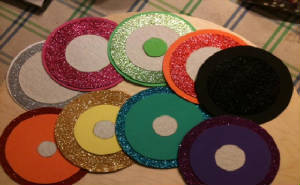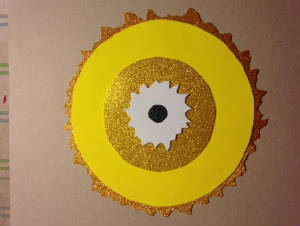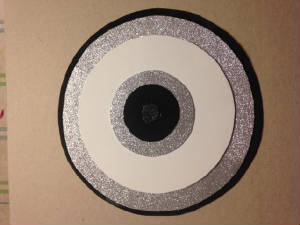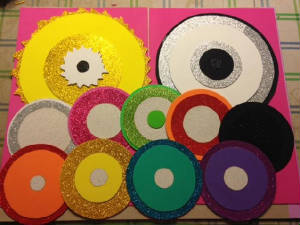|
|
Sidewalk Astronomy for the Blind by Peggy Walker
-Broken Arrow Sidewalk Astronomers
BA Sidewalk Astronomer has done astronomy outreach now since IYA 2009…… and we often get asked, “Aren’t you tired of doing the same thing over, and over again?” Well…a good sidewalk astronomer, who has established good partnerships in the community would not just set up scopes - but become an observer…… An observer of people. Who consistently comes to your events? What part of the population are they? Is there anything memorable about them?
BASWA has done monthly sidewalk astronomy at a local pizza establishment now for six years on the Saturday night of the first quarter moon. Saturday at Hideaway Pizza has various sports teams and families that oftentimes have the restaurant crowded out. So when the staff encourages their patrons to go look through the telescopes it is great. But something we noticed, was how when multi generational families would come, the grand children, and their parents were encouraged to look through the telescope while the grandparents would stand and watch.
Was it lack of interest….. boredom…. Or a time issue.? Neither. It was a vision issue. At our other site, Starbucks Coffee a gentleman in his early forties encouraged his wife to look while he stood there with his cane. He had retinitis pigmentosis which prompted me to do some research when I got home. I found Project Bright Sky’s website with some great images of the actual vision that eye diseases cause. So this got us rethinking how we SWA. Yes, there are many things people do for visually impaired people like video cameras and large TV screens or laptops. But a totally blind person would need some other resource. Something we developed that is simple to make and will attract people is from supplies from a craft store.
I made the internal structure of the planets, the sun and moon out of craft supplies. I used three materials – smooth foam core, glitter foam core and sandpaper. Most hobby or craft stores have packets of pre-cut circular foam cores in various colors but the sandpaper has to come from a hardware or home repair store. I made all the planets the same size which would make it easy for them to compare to each other. I used colors that best resembled the planets so that I didn’t have to label them. That being said, you may want to get Braille labels made to put on them. The colors may not be exactly the same but there is plenty of options out there to make it work.
My set of planets is divided into two groups the top row being terrestrial planets and the bottom row being the gas giants. Mercury is white 6 ¼ diameter circle of smooth foam core which represents the crust; a 5 ¾ diameter circle of white or silver glitter foam core for the mantle, and a 4 ½ coarse sandpaper in white or a light color for the core. Venus is pink 6 ¼ smooth foam core which represents the crust; a 5 ½ diameter circle of pink glitter foam core for the mantle and 3 ¼ sand paper – white or light colored for the core. Earth was 6 ¼ smooth green foam core as the crust; 5 ¾ glitter green foam core for the upper mantle; 3 ¾ white/light coarse sandpaper for lower mantle, and 1 ½ smooth green foam core for the inner core. Mars was a smooth red 6 ¼ diameter circle for the crust; 5 ¼ red glitter foam core mantle, and a 3 ½ white/light sandpaper core. Pluto has a 6 ¼ smooth black foam core crust; 4 ¾ black glitter foam core for inner core.
On the bottom level are the gas giants starting with Jupiter with a 6 ¼ glitter foam core since there is no crust surface; 5 ¼ smooth orange foam core for the mantle; and 1 ¼ white/light colored coarse sand paper for the inner core. Saturn is in yellow with a 6 ¼ yellow glitter foam core atmosphere, 3 ¾ smooth foam core mantle; and 1 ½ white/light sand paper core. Uranus with glitter turquoise or teal 6 ¼ circle foam core for atmosphere, 5 inch smooth foam core and a 1 ½ white or light coarse sand paper core. Neptune in dark blue or purple glitter circle of 6 ¼ inch atmosphere, 5 inch smooth foam core circle and 1 ¾ white sandpaper core.
When you sidewalk and show the visitors a planet, now you can show everyone the planet’s internal structure. In fact, you can make a sun and a moon which are the two main sidewalk objects. The sun is a 12 inch yellow glitter foam core that was 2 pieces of glitter foam core pieces taped together. That represents the corona and was cut with some flames on the edge; 10 ¾ smooth yellow foam core for the convection zone; 6 ¾ yellow glitter foam core for the radiative zone; a 4 inch white circle with flames for the nuclear fusion in the core and a 1 inch black glitter foam core on top.
The moon is a smooth black circle 11 inch for the crust; 10 ¼ sliver glitter for upper mantle; smooth white foam core 8 inches for mid mantle; 4 ½ silver glitter lower mantle and a 3 inch smooth foam core for the outer core and 1 inch black glitter or white sandpaper solid inner core.
These can be easily stored in a large Ziploc bag and taken to any outreach site.
The more you think out of the box, and do something different or unexpected, it gives you the answer to the question. No, it isn’t tiring because you just keep making it interesting. And truth be told, there is nothing cooler than watching the light bulb go off above the head of the visually impaired person when they get what it is you are sharing with them
|



